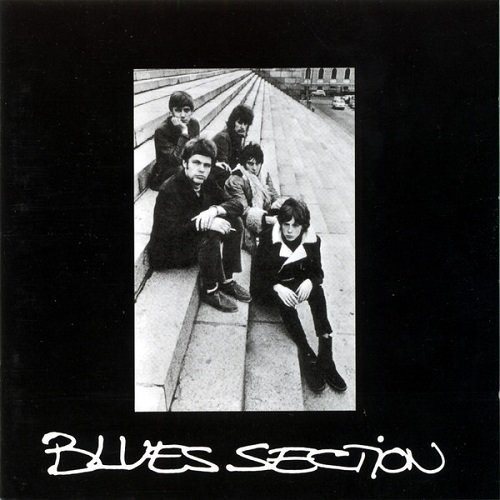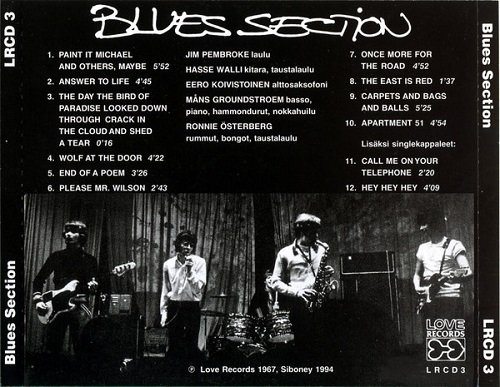Blues Section - Blues Section (Reissue, Remastered, Bonus Tracks) (1967/1994)

Artist: Blues Section
Title: Blues Section
Year Of Release: 1967/1994
Label: Love Records
Genre: Psychedelic Rock, Blues Rock
Quality: Mp3 320 / Flac (image, .cue, log)
Total Time: 45:50
Total Size: 117/199 Mb (scans)
WebSite: Album Preview
Title: Blues Section
Year Of Release: 1967/1994
Label: Love Records
Genre: Psychedelic Rock, Blues Rock
Quality: Mp3 320 / Flac (image, .cue, log)
Total Time: 45:50
Total Size: 117/199 Mb (scans)
WebSite: Album Preview

Tracklist:
01. Paint It Michael And Others, Maybe
02. Answer To Life
03. The Day The Bird of Paradise...
04. Wolf At The Door
05. End Of A Poem
06. Please Mr. Wilson
07. Once More For The Road
08. The East Is Red
09. Carpets And Bags And Balls
10. Apartment 51
Bonus Tracks:
11. Call Me On Your Telephone
12. Hey Hey Hey
Personnel:
Jim Pembroke: vocals
Hasse Walli: guitar
Eero Koivistoinen: saxophone
Mans Groundstroem: bass
Ronny Osterberg: drums
Blues Section were not together long, only a year and a half, but during that period they managed to revolutionise the Finnish rock music scene. The band played an enormous number of gigs, recorded frequently, and were involved in many other activities. The essential novelty on these latitudes, however, was the uncompromising style and attitude of the band.
Blues Section were founded in spring 1967. Inspired by John Mayall's Bluesbreakers, guitarist Hasse Walli of the Jormas and bassist Måns Groundstroem of the Roosters had become greatly interested in furious R&B, agreeing that it was time for Finland to step further from the accustomed beat pop course. In May their faith was strengthened by Jimi Hendrix who created an ineffaceable influence on his Helsinki concert audience. These astonishing trends in pop music were observed by the young jazz and intellectual circles, as well. Atte Blom and Otto Donner had been launching a new progressive record company, Love Records, and were searching for a proper rock band to be taken under its wing.
These two fronts came to know each other in the "jukebox jury" of the Nya Pressen newspaper. Thus, Love Records found the rock players they were longing for, while the young blues enthusiasts got a publisher for their music. Blues Section found a vocalist in Briton Jim Pembroke in whose backing-group, the Pems, Groundstroem had earlier played. Because of its innovation, some jazz players also became interested in this pop musicians' project. Edward Vesala joined the band as drummer, bringing along alto saxophonist Eero Koivistoinen. The latter stayed in the band, but Vesala was replaced by Raimo Rautarinne from the Roosters. Rautarinne was, himself, replaced by Ronnie Österberg who had last played in the Islanders, and before that also in Pembroke's band.
Blues Section in studio Already on their earliest gigs Blues Section showed what the new wild course was like. The crowd marveled open-mouthed at smoke-bombs, howling amplifiers, and other show tricks. But also, and above all, the music was of a new kind, with the band playing a Bluesbreakers, Yardbirds, Jimi Hendrix and Cream repertoire with a strong intensity. Walli's electric guitar and Koivistoinen's saxophone performed a dialogue the like of which had never been seen. Blues Section soon became Finland's number one band, and also visited Sweden many times, providing them with something to wonder at. Gradually, Blues Section's live performances began to draw away from basic blues, becoming more and more improvised and jazzy, but most importantly, their uncompromising feeling and attitude remained. Along with recordings, the group also performed their own songs on gigs to some extent.
As a rule, before Blues Section Finnish pop bands had recorded only material selected or approved by the record company, commercial potential being the guiding principle. Blues Section were the first Finnish band able to make records to their own liking without this hit pressure, although the Love Records staff were deeply involved in the group's activities. However, now it was a question of a fruitful co-operation, not a dictatorship. Blues Section recordings - Blues Section album 1967, a couple of singles, compilation Some of Love 1969, and some other tracks - included predominantly more pop-ish stuff than their live repertoire. On the other hand, the recording studio opened the possibility of utilising the wonders of modern technology, so some of the tracks were quite experimental in the spirit of the Beatles and other psychedelicatessens of the time. Almost all of the recorded songs were penned by the band members or close partners. In particular, Pembroke showed his talent as a writer of excellent melodies: he created great pop songs - not blues pieces. Walli also composed a few tracks, in addition to whom the background cast of Donner, Blom and Eero Ojanen penned experimental works for the band's records. Blues Section line-ups, adapted in different ways, also accompanying singers Kirka and Ronnie on their singles, and participated in Donner's and Love's other projects, including soundtracks for films.
In spring 1968 Groundstroem left the band in order to concentrate on his studies. He was replaced by jazz bassist Pekka Sarmanto. Then Jim Pembroke got tired of the band, and another Briton, Frank Robson from Mosaic, was hired as singer. The new personnel continued together for a few months, making a couple of recordings, but Walli and the band's jazz musicians were getting involved in too many other activities. In the summer Koivistoinen left the band, and Blues Section finally split up in autumn 1968, with Sarmanto going to serve his time as a conscript.
Walli went on playing in the Otto Donner Treatment, Österberg and Koivistoinen in the Boys, and Sarmanto later in the jazz circles. Robson left for England, returning in 1969 to join Tasavallan Presidentti, founded by Groundstroem. Pembroke worked at Love's office till early 1969, then joined Wigwam who had been founded by Österberg. Blues Section musicians thus gave birth to the two most important Finnish rock bands of the early seventies. Wigwam and Tasavallan Presidentti recorded for Love, and although the bands quite clearly differed from each other in terms of musical tastes, both of them in a way continued the line opened by Blues Section with artistic integrity outweighing commercial targets. Blues Section have reformed a couple of times to play a few concerts.
Translation checked by Mark Jones
Blues Section were founded in spring 1967. Inspired by John Mayall's Bluesbreakers, guitarist Hasse Walli of the Jormas and bassist Måns Groundstroem of the Roosters had become greatly interested in furious R&B, agreeing that it was time for Finland to step further from the accustomed beat pop course. In May their faith was strengthened by Jimi Hendrix who created an ineffaceable influence on his Helsinki concert audience. These astonishing trends in pop music were observed by the young jazz and intellectual circles, as well. Atte Blom and Otto Donner had been launching a new progressive record company, Love Records, and were searching for a proper rock band to be taken under its wing.
These two fronts came to know each other in the "jukebox jury" of the Nya Pressen newspaper. Thus, Love Records found the rock players they were longing for, while the young blues enthusiasts got a publisher for their music. Blues Section found a vocalist in Briton Jim Pembroke in whose backing-group, the Pems, Groundstroem had earlier played. Because of its innovation, some jazz players also became interested in this pop musicians' project. Edward Vesala joined the band as drummer, bringing along alto saxophonist Eero Koivistoinen. The latter stayed in the band, but Vesala was replaced by Raimo Rautarinne from the Roosters. Rautarinne was, himself, replaced by Ronnie Österberg who had last played in the Islanders, and before that also in Pembroke's band.
Blues Section in studio Already on their earliest gigs Blues Section showed what the new wild course was like. The crowd marveled open-mouthed at smoke-bombs, howling amplifiers, and other show tricks. But also, and above all, the music was of a new kind, with the band playing a Bluesbreakers, Yardbirds, Jimi Hendrix and Cream repertoire with a strong intensity. Walli's electric guitar and Koivistoinen's saxophone performed a dialogue the like of which had never been seen. Blues Section soon became Finland's number one band, and also visited Sweden many times, providing them with something to wonder at. Gradually, Blues Section's live performances began to draw away from basic blues, becoming more and more improvised and jazzy, but most importantly, their uncompromising feeling and attitude remained. Along with recordings, the group also performed their own songs on gigs to some extent.
As a rule, before Blues Section Finnish pop bands had recorded only material selected or approved by the record company, commercial potential being the guiding principle. Blues Section were the first Finnish band able to make records to their own liking without this hit pressure, although the Love Records staff were deeply involved in the group's activities. However, now it was a question of a fruitful co-operation, not a dictatorship. Blues Section recordings - Blues Section album 1967, a couple of singles, compilation Some of Love 1969, and some other tracks - included predominantly more pop-ish stuff than their live repertoire. On the other hand, the recording studio opened the possibility of utilising the wonders of modern technology, so some of the tracks were quite experimental in the spirit of the Beatles and other psychedelicatessens of the time. Almost all of the recorded songs were penned by the band members or close partners. In particular, Pembroke showed his talent as a writer of excellent melodies: he created great pop songs - not blues pieces. Walli also composed a few tracks, in addition to whom the background cast of Donner, Blom and Eero Ojanen penned experimental works for the band's records. Blues Section line-ups, adapted in different ways, also accompanying singers Kirka and Ronnie on their singles, and participated in Donner's and Love's other projects, including soundtracks for films.
In spring 1968 Groundstroem left the band in order to concentrate on his studies. He was replaced by jazz bassist Pekka Sarmanto. Then Jim Pembroke got tired of the band, and another Briton, Frank Robson from Mosaic, was hired as singer. The new personnel continued together for a few months, making a couple of recordings, but Walli and the band's jazz musicians were getting involved in too many other activities. In the summer Koivistoinen left the band, and Blues Section finally split up in autumn 1968, with Sarmanto going to serve his time as a conscript.
Walli went on playing in the Otto Donner Treatment, Österberg and Koivistoinen in the Boys, and Sarmanto later in the jazz circles. Robson left for England, returning in 1969 to join Tasavallan Presidentti, founded by Groundstroem. Pembroke worked at Love's office till early 1969, then joined Wigwam who had been founded by Österberg. Blues Section musicians thus gave birth to the two most important Finnish rock bands of the early seventies. Wigwam and Tasavallan Presidentti recorded for Love, and although the bands quite clearly differed from each other in terms of musical tastes, both of them in a way continued the line opened by Blues Section with artistic integrity outweighing commercial targets. Blues Section have reformed a couple of times to play a few concerts.
Translation checked by Mark Jones






![Rachel Kitchlew, SFJ - Flirty Ghost (2025) [Hi-Res] Rachel Kitchlew, SFJ - Flirty Ghost (2025) [Hi-Res]](https://www.dibpic.com/uploads/posts/2025-12/1765896408_qvf41hr1ljj8a_600.jpg)

